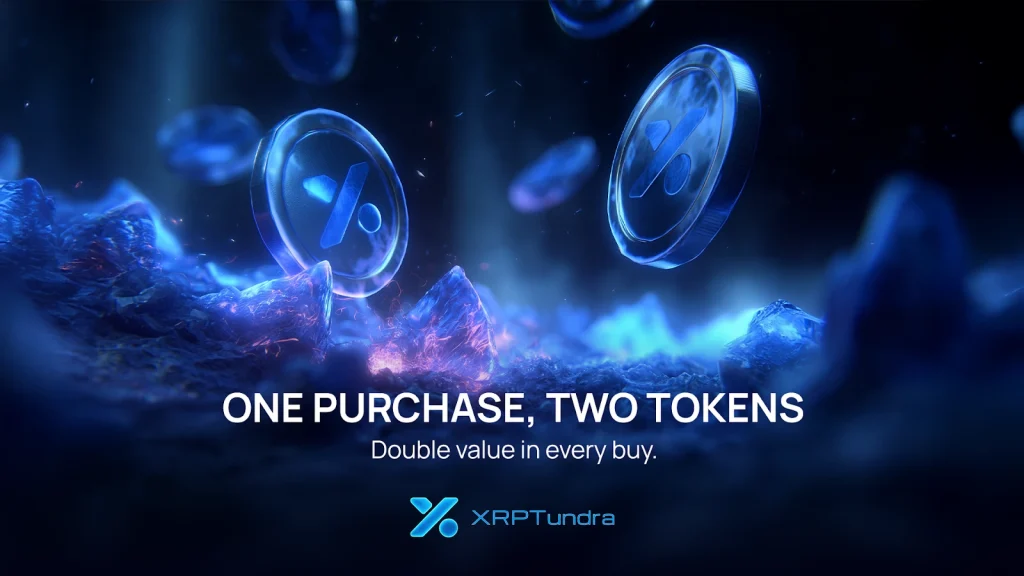XRP’s reputation has outlasted multiple market cycles, but 2025 has changed the conversation. Regulatory clarity is now settled, and analysts openly discuss the odds of an XRP exchange-traded fund following the approvals of Bitcoin and Ethereum ETFs. Attention has moved from courtroom drama to allocation — how investors position themselves inside a clearer framework.
That shift has revived XRP’s status as an investable asset rather than a speculative trade. And within that momentum, XRP Tundra has emerged as the structured extension of the XRP ecosystem: a dual-chain DeFi platform that turns passive holding into measurable yield through its Cryo Vault staking system and verified token architecture.
ETF Speculation Meets Structured Utility
ETF speculation alone doesn’t build value, but it defines sentiment. Institutional desks that once avoided XRP now model it alongside BTC and ETH as a potential regulated product. The reason is simple: with the SEC case resolved in August 2025 and public-exchange sales ruled non-securities two years earlier, XRP carries the legal clarity required for mainstream instruments.


While fund issuers await for SEC decision, retail and early investors have already started seeking yield-based exposure instead of waiting for approval. Tundra offers that route. It mirrors the discipline of traditional finance — fixed pricing, verified audits, and documented tokenomics — but applies it to a yield layer that works today, not months after an ETF filing.
Yield That Freezes Value
At the core of this system are Cryo Vaults, the frozen finance mechanism that defines Tundra’s architecture. Holders can lock assets through Frost Keys, choosing durations from short seven-day cycles to extended ninety-day commitments. Returns scale with time, reaching annualized rates near 30 %, funded by Solana-side liquidity fees instead of token inflation.
Vault logic is fully on-chain, connecting directly to TUNDRA-S pools managed under Meteora’s DAMM V2 dynamic-fee model. As liquidity generates transaction revenue, rewards flow proportionally to stakers. The design links yield to real activity, not emission schedules—stability built into function rather than marketing.
Two Chains, Two Functions
TUNDRA-S on Solana powers liquidity, staking, and reward distribution; TUNDRA-X on the XRP Ledger governs parameters and reserves. Every presale purchase delivers both tokens at a one-to-one ratio, giving holders exposure to yield performance and decision weight.


This split mirrors institutional asset logic: operations and oversight separated by design. Solana’s throughput maintains execution speed, while XRPL’s reliability ensures transparent record-keeping. Together, they create a model that combines DeFi efficiency with the accountability regulators now expect from ETF-grade assets.
Fixed Math, Defined Potential
Phase 6 of Tundra’s presale still runs on the $0.1/$0.05 bracket for TUNDRA-S and TUNDRA-X, paired against confirmed listing prices of $2.5 and $1.25. The arithmetic defines a potential 2,400 % window at launch. Over 11 600 participants have contributed $1.2 million +, according to on-chain data.
Each new phase introduces slight, pre-announced increases, keeping the process controlled and transparent. All figures — supply, bonuses, and vesting — are published before activation. Independent audits from Cyberscope, Solidproof, and FreshCoins confirm contract security, while Vital Block KYC verifies the development team.
This approach leaves little ambiguity: entry prices, listing targets, and governance distribution are already measurable — conditions rarely seen in early-stage crypto sales.
From Passive Holding to Active Yield
For long-time XRP investors, Tundra represents a functional extension of the asset they already know. The ecosystem turns a settled, ETF-ready token into the backbone of a yield network with defined parameters. In effect, XRP remains the foundation; Tundra builds the utility on top.
A detailed review from Crypto Volt outlined how this architecture transforms speculative exposure into structured income. The analysis described Cryo Vaults as “staking built for compliance,” pointing out that verified math now sits where hype used to.
If an XRP ETF eventually materializes, it will formalize institutional access. Tundra offers something parallel for retail participants — regulated logic without waiting for regulators. It’s the same underlying narrative expressed in code instead of filings.
In a market obsessed with approval dates, Tundra already behaves like the product those approvals would enable:
Website:https://www.xrptundra.com
Medium:https://medium.com/@xrptundra
Telegram:https://t.me/xrptundra
X:https://x.com/Xrptundra
Contact: Tim Fénix — contact@xrptundra.com


 Bitcoin
Bitcoin  Ethereum
Ethereum  Tether
Tether  XRP
XRP  Solana
Solana  USDC
USDC  Lido Staked Ether
Lido Staked Ether  Dogecoin
Dogecoin  TRON
TRON  Cardano
Cardano  Wrapped stETH
Wrapped stETH  Wrapped Bitcoin
Wrapped Bitcoin  Chainlink
Chainlink  Figure Heloc
Figure Heloc  Ethena USDe
Ethena USDe  Wrapped eETH
Wrapped eETH  Hyperliquid
Hyperliquid  Stellar
Stellar  Bitcoin Cash
Bitcoin Cash  Sui
Sui  Avalanche
Avalanche  WETH
WETH  Binance Bridged USDT (BNB Smart Chain)
Binance Bridged USDT (BNB Smart Chain)  LEO Token
LEO Token  USDS
USDS  Hedera
Hedera  Coinbase Wrapped BTC
Coinbase Wrapped BTC  USDT0
USDT0  Litecoin
Litecoin  Mantle
Mantle  Shiba Inu
Shiba Inu  WhiteBIT Coin
WhiteBIT Coin  Monero
Monero  Cronos
Cronos  Toncoin
Toncoin  Ethena Staked USDe
Ethena Staked USDe  Polkadot
Polkadot  Dai
Dai  Zcash
Zcash  Bittensor
Bittensor  Uniswap
Uniswap  World Liberty Financial
World Liberty Financial  ChainOpera AI
ChainOpera AI  Aave
Aave  OKB
OKB  MemeCore
MemeCore  Bitget Token
Bitget Token  Ethena
Ethena